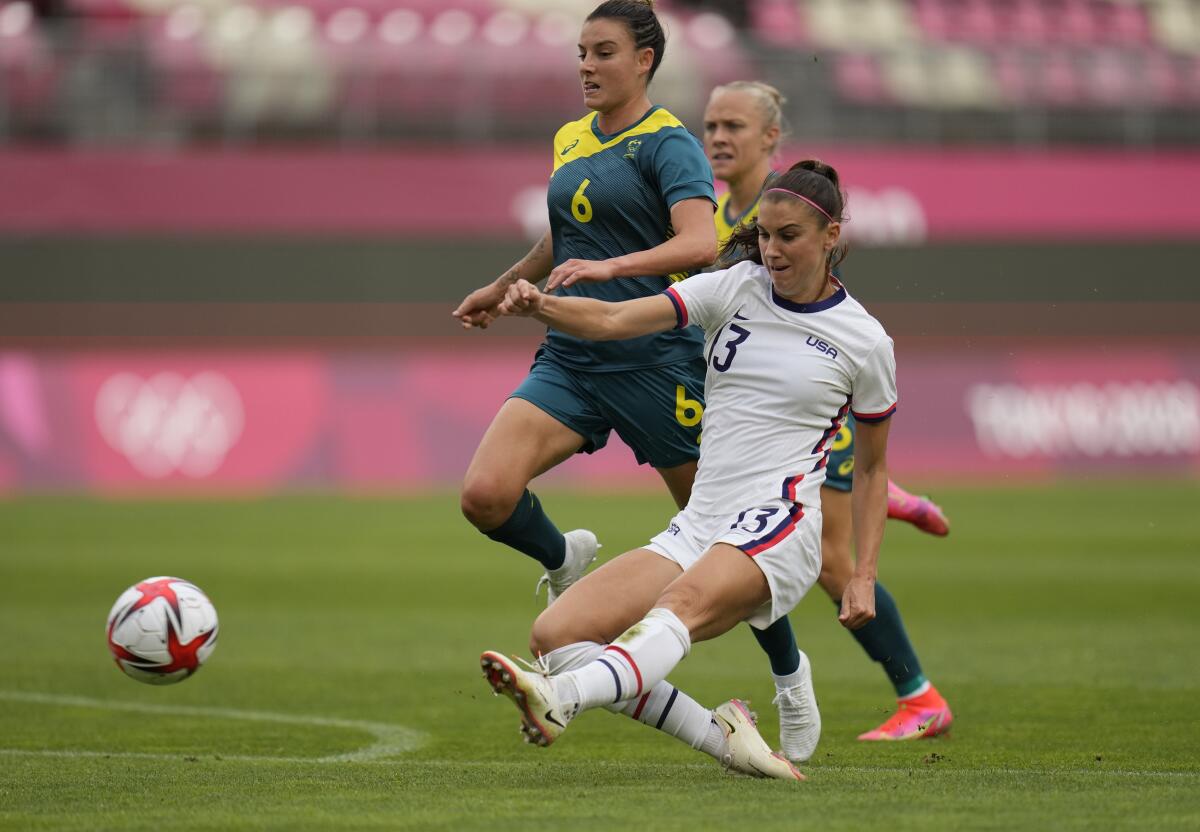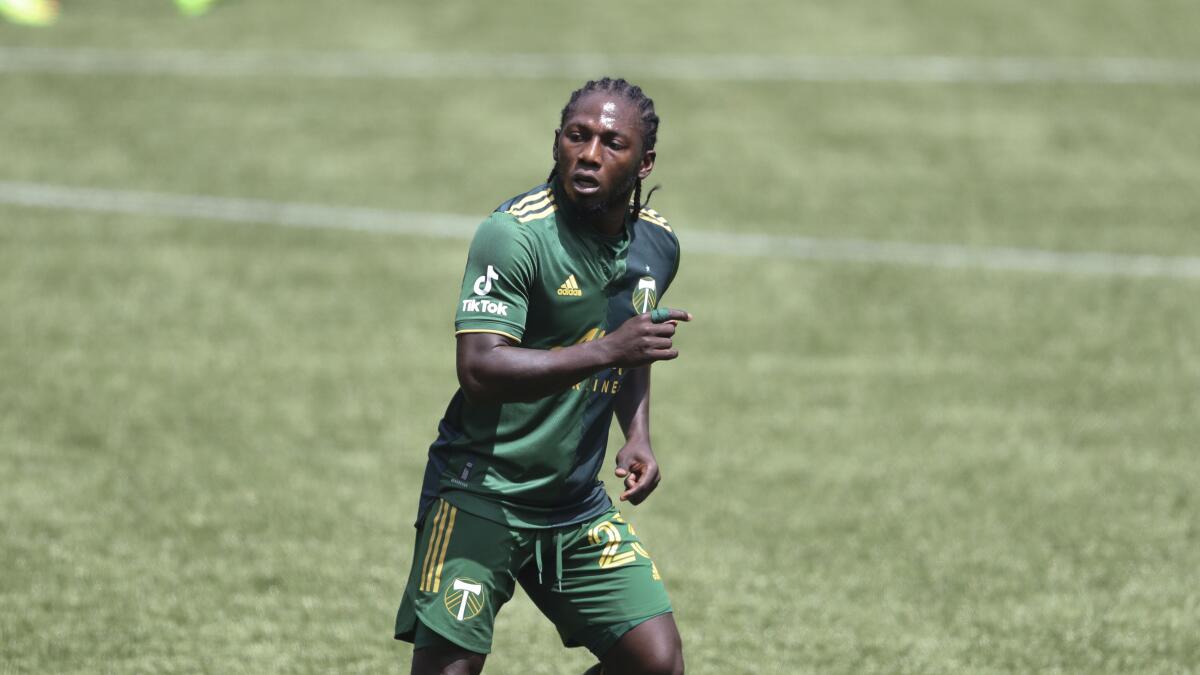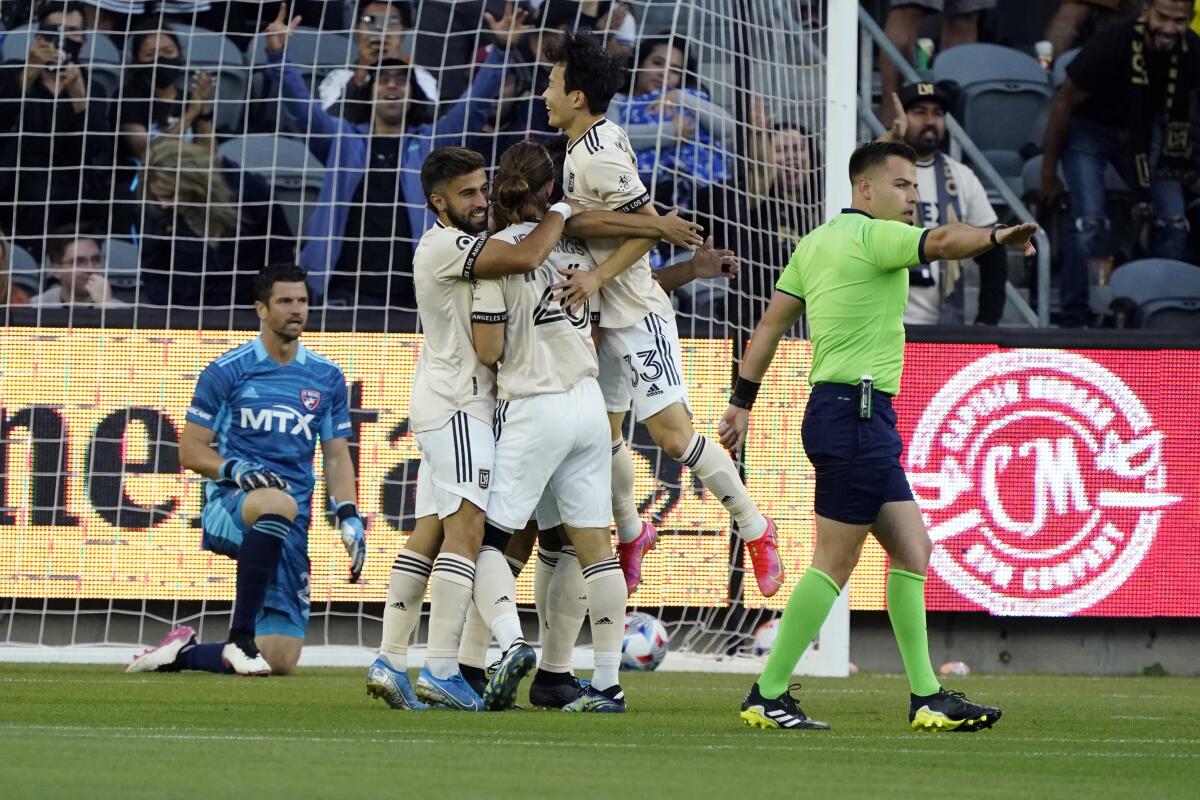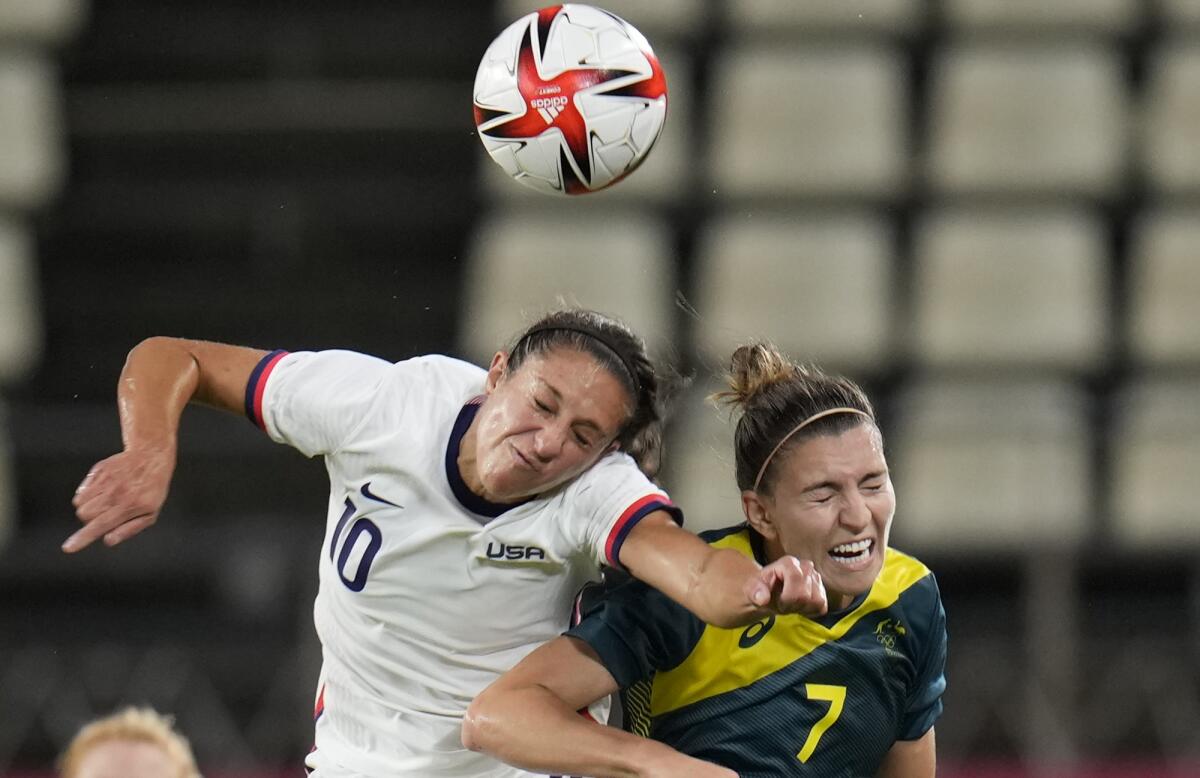Here is why the USWNT is struggling to win gold at the Tokyo Olympics

- Share via
Hello and welcome to the L.A. Times soccer newsletter. I’m Kevin Baxter, the Times’ soccer writer, coming to you a day later than usual from Japan, where the women’s national team and Mexico’s U-24 team are both moving on to the quarterfinals of the Olympic tournament, the Americans after an uninspiring scoreless draw with Australia early Tuesday morning California time and the Mexicans after an easy 3-0 win over South Africa early Wednesday morning.
That keeps alive the Americans’ dream of becoming the first team of any gender to win World Cup and Olympic titles in the same cycle, while for Mexico its second gold medal in three Summer Games is now closer than ever.
For the U.S. women, accomplishing that dream won’t be easy — in fact it’s probably impossible — if they keep playing like they have for the first week of the Tokyo Games.
Before the team left for Japan, I asked coach Vlatko Andonovski about the challenge of managing in his first international tournament. He said he was unconcerned. With a roster that included 17 players from the World Cup championship team of 2019, he was confident there was enough experience in the locker room to help him through.
“I don’t shy away from asking questions from the players,” he said. “I want to know everything. Just because I haven’t been there, haven’t experienced that, I want to know firsthand from people that have done it.”
Three games into the Tokyo tournament that looks to be wishful thinking.
The U.S., which hadn’t been shut out in four years, has been blanked twice in three games in Japan. After going 23 games without a loss under Andonovski, the Americans have won just once since getting here.
And while a win and a draw in three group-stage games was enough to get the team through to the quarterfinals, it will face the Netherlands on Friday in a rematch of that World Cup final. The Dutch have scored 21 times in their three games here. The U.S. hasn’t taken 21 shots on goal.
Andonovski asked his team to play conservatively against Australia, which clearly didn’t fit a cocky, confident team that is used to going for the jugular. On its few scoring chances, the U.S. seemed to pull up, play it safe. As a result, Aussie goalie Teagan Micah, a former UCLA keeper, made four relatively easy saves. The only time she was tested, in the 31st minute when she was beaten by an Alex Morgan header, the goal was waved off because Morgan was offside.
It’s likely Andonovski didn’t ask his veteran players how they felt about his game plan because they didn’t look happy ceding possession to Australia for nearly 60 of the 90 minutes. The Aussies completed more passes than the U.S. even attempted. That probably didn’t sit well either

It’s been a poor start for the U.S., which was dominated by Sweden, beat New Zealand in a game that was in doubt until the final 10 minutes, then appeared content not to lose to Australia rather than trying to win. In the first and last games Andonovski’s team has been lackluster, disorganized and uninspired — and every bit as old as their passports say they are.
All that will be forgotten if the U.S. beats the Netherlands and makes a run for another title. The team’s own lofty standards make anything less than a spot in the final a failure — that’s what happens when you win four of the first five Olympic tournaments.
After Tuesday’s result, the U.S. has won just one of its last five Olympic games. Now they’re on to a knockout stage in which all eight teams are ranked among the top 10 in the world by FIFA. Four of the eight, including the U.S., made the semifinals of the last World Cup.
“You can’t think about really future games without thinking about the next game,” Morgan said. “So for us, it’s looking at the upcoming games and seeing who we’re going to face. And then after that, it’s, you know, seeing how Vlatko wants us to set up against that team.
“We’re experienced enough and professional enough to be able to do so. We’ll look forward to that now. Obviously we need to build off of this momentum as well.”
What momentum?
Meanwhile Mexico (2-1-0) is on to the men’s quarterfinals for just the second time in a quarter-century. The last time El Tri made it this far, in London in 2012, it won the gold medal.
The goals Wednesday went to Alexis Vega and Luis Romo in the first half and Henry Martin in the second.
Mexico will face South Korea in Saturday’s quarterfinals. The Koreans won bronze behind Mexico nine years ago and made the quarterfinals in Brazil in 2016. South Korea leads the Tokyo tournament with 10 goals in three games which conceding once.
Enjoying this newsletter? Consider subscribing to the Los Angeles Times
Your support helps us deliver the news that matters most. Become a subscriber.
Qatar making the most of its Gold Cup invitation
Speaking of tournament victories, Mexico and the U.S. are on to the semifinals of the CONCACAF Gold Cup, which isn’t surprising since it’s been 16 years that either failed to reach the final four of the confederation championship.
What is surprising is the Americans’ opponent in Thursday’s Final Four.
Qatar, the reigning Asian Cup champion, was invited to play in the tournament as part of a 2018 agreement between CONCACAF and the Asian confederation to support the growth of soccer in Asia. And now, after beating El Salvador in the quarterfinals, Qatar has a chance to win the Gold Cup, which would make it the first team in modern history to hold two confederation titles at the same time.
It wouldn’t be a fluke. Qatar has invested heavily in its national team ahead of next year’s World Cup, which it will host, and the spending has paid off. Qatar is unbeaten in its last 12 games dating to December, with two wins over El Salvador, single victories over Honduras and Croatia’s U-21 team and draws with Panama and Ireland. That has helped the country go from 102nd in the FIFA world rankings in 2017 to 58th today.
Qatar’s Spanish coaching staff, led by manager Félix Sánchez, a former Barcelona youth coach, has put together an experienced, domestic-based team that features nine of the 23 players it brought to the Gold Cup having at least 65 international caps. And it has played well in the tournament, scoring 12 times in four wins — four of those goals coming from Almoez Ali, a 24-year-old, Sudanese-born forward who is Qatar’s active leading scorer with 34 goals in 66 games.

The U.S., 20th in the latest FIFA rankings, will post its toughest test. Coach Gregg Berhalter is using a “B” team — my term, not his — in this tournament and the U.S. has lost just once since October 2019 after beating Jamaica 1-0 in Sunday’s quarterfinals. The U.S. is 15-1-1 since a Nations League loss to Canada and has posted shutouts in 10 of those games, including three of its four wins in the Gold Cup. The Americans’ quarterfinal win came on Matthew Hoppe’s first international goal in the 83rd minute.
Mexico will play Canada, a 2-0 winner over Costa Rica, in the other semifinal. El Tri, which hasn’t allowed a goal in its last seven games, got off to a slow start in the Gold Cup when it lost top scoring threat Hirving Lozano to a head injury in its first game, a scoreless draw with Trinidad and Tobago.
Rogelio Funes Mori has filled some of the void left by Lozano’s absence with three goals in as many games for Mexico, which has won four of the last six Gold Cups. The last time a country other than the U.S. or Mexico won the confederation tournament was 2000, when Canada beat Colombia, an invited guest, in the final.

It’s time for MLS to get real when it comes to grass
LAFC coach Bob Bradley said the quiet part out loud after last week’s loss to Portland on the FieldTurf Revolution surface at Providence Park: fake grass is hurting the level of play in MLS.
“Turf is hard to play on, plain and simple,” he began. “The guys that watch football around the world, you should be able to see the differences in the way the ball bounces, the timing, everything, when a game’s played on a top grass field that’s wet, where the ball’s moving quick and fast and then on turf where there’s all sorts of rubber and it bounces up all the time.
“That’s not easy. You deal with it. I wait for the day when every field in the league is perfect natural grass.”
That day probably is a long way off. MLS has opened 24 soccer-specific stadiums since 1999, but the number of artificial-turf fields in the league actually is increasing. Seattle, New England, Atlanta and Vancouver all share stadiums with tackle-football teams that play on faux grass, as will Charlotte when it joins the league in 2022.
Compare that with the major European leagues, where many teams play on hybrid surfaces, reinforced natural grass fields that include reinforcing synthetic fiber.
“It will make the games better. It makes the quality of play better,” Bradley said of natural grass fields. “It’s not talked about enough. When you go to places and play on turf you have to prepare, you understand the way the game is going to be played.”
Even coaches of teams whose owners force them to play home games on turf fields would agree, Bradley said — if they were allowed to speak freely.
“It’s not about coaches complaining about it,” he said. “The decisions as to what surfaces we have in the league get made on a higher level than the coaches. I think if you asked probably every coach in the league, everyone would say exactly what I’m saying.
“Now the guys that coach teams where the home stadium is artificial turf, they can’t say what I’m saying right now. That wouldn’t work. But behind the scenes or anonymously, they would all agree, I promise you.”

MLS ‘dog days’ arrive with a bite for LAFC, Galaxy
The dog days of the MLS summer have arrived, leaving LAFC and the Galaxy panting for breath but holding their own in a tight Western Conference playoff chase.
LAFC had to rally for a 2-2 draw with Vancouver last Saturday to salvage a point from its last two games, but it remained fifth in a crowded table in which seven teams are separated by just eight points. More important, however, is the fact Carlos Vela has scored in three consecutive games for the first time since 2019.
And the attack, which hasn’t scored more than two goals in a game this season, is about to get an added boost with the addition of forward Cristian Arango from Colombia’s Millonarios, the latest player landed by Bogota-based super scout Juan Pablo Angel.
LAFC laid the necessary foundation for that deal late Monday when it traded midfielder Mark-Anthony Kaye, a former MLS All-Star and just one of seven players remaining from the franchise’s original roster in 2018, to the Colorado Rapids for Tuesday for $1 million in allocation money and a 2022 international roster spot.
In addition, LAFC will receive 10% of the transfer fee should the Rapids sell Kaye abroad for at least $1 million while Colorado gets LAFC’s first-round pick in the 2022 MLS SuperDraft. The trade will leave LAFC with a big hole to fill, and not for Kaye’s play, which has been erratic at times this season. But mostly for this leadership
“He’s come so far in such a short period of time,” LAFC general manager John Thorrington said. “It’s tough, but it’s the reality we have to accept when we live in a cap constraint world. It was a tough decision, but one we felt was necessary.
“Mark’s been an important part of LAFC from the very beginning. He’s an excellent guy and I really enjoyed working with him and wish him nothing but the best moving forward.”
Kaye, 26, who is on international duty with Canada, appeared in 77 games (71 starts) in four seasons, scoring nine goals and registering 18 assists. But he was made expendable, on the field at least, by the emergence of 22-year-old Ecuadoran midfielder José Cifuentes, who is tied for the team lead with five goals.
In Colorado, Kaye will be reunited with defender Steven Beitashour, another original LAFC player.

As for Arango, LAFC is awaiting league approval on a TAM-financed transfer for the 26-year-old, who scored 22 times in 58 appearances for Millonarios. With LAFC he is expected to play as a center forward between Vela and Diego Rossi, filling the hole created when the team declined a contract option on Bradley Wright-Phillips last fall.
LAFC, which has lost just once in July, actually is succeeding with defense. The team’s hot streak coincides with Tomás Romero’s insertion into the lineup in goal and Bradley’s decision to use Moon-hwan Kim and Raheem Edwards as speedy wingers playing out of a five-man backline. That has helped the team climb eight spots in the standings since mid-May, from the conference cellar into playoff contention.
“The tactical flexibility we chose so far has been good,” Bradley said.
Meanwhile the Galaxy’s once-promising season hit a bump in the road — or rather a bump on the road — with Greg Vanney’s team collecting a lone point from three matches in Utah and Texas. It lost to Western Conference bottom-dwellers Vancouver and FC Dallas and came from two goals down to draw with Real Salt Lake.
The Galaxy’s three losses in July match their total from the rest of the season combined, and their three-game winless streak is their longest since last October. But Vanney, whose team was missing four starters to injury and international duty Saturday, is a long way from pushing the panic button.
“It’s MLS, which some of these guys are learning a little bit about,” he said after Saturday’s loss to FC Dallas in which Ricardo Pepi had as many goals, three, as the Galaxy had shots on target. “Three games in the week, two at altitude and one in really warm and humid conditions.”
Saturday’s game was played in 96-degree temperatures in Dallas; the previous two were at altitude in Sandy, Utah. Five of the Galaxy starters, all recent imports from Europe, never had faced such difficult conditions in close succession.
“I think it is more physical than mental,” MLS veteran Sacha Kljestan said. “We’ve all played three games in a week many times in our careers, but that’s probably peak MLS as far as how hard it can be conditions-wise.
“For some of our younger guys, for some of our foreign guys that are new to the league, that’s a real shock to the system. [It’s a] learning curve for us.”
A learning curve currently proving too steep for the team, which has gone 1-3-1 and been outscored 11-6 since Javier “Chicharito” Hernández, the team’s leading scorer, went to the sidelines last month with a calf injury. That’s the same injury that cost him two months last season.
Surprisingly the slump hasn’t cost the team any ground in the standings. It’s still third, a point ahead of fourth-place Colorado.
And finally there’s this….
U.S. Soccer has selected TQL Stadium, the 26,000-seat home of FC Cincinnati, as the site for its Nov. 12 World Cup qualifier with Mexico. It will mark the first time since 1997 that the U.S. has not played its final-round qualifier with Mexico in Columbus, Ohio.
Podcast
Don’t miss my weekly podcast on the Corner of the Galaxy site as co-host Josh Guesman and I discuss the Galaxy each Monday. You can listen to the most recent podcast here.

Quotebook
“We need to be ruthless. Ruthless mentality, grit and hard fight. That should be a standard thing that you’re doing every game.”
U.S. forward Carli Lloyd on her team’s approach to the Tokyo Olympic tournament.
Until next time...
Stay tuned for future newsletters. Subscribe here, and I’ll come right to your inbox. Something else you’d like to see? Email me. Or follow me on Twitter: @kbaxter11.
Go beyond the scoreboard
Get the latest on L.A.'s teams in the daily Sports Report newsletter.
You may occasionally receive promotional content from the Los Angeles Times.




